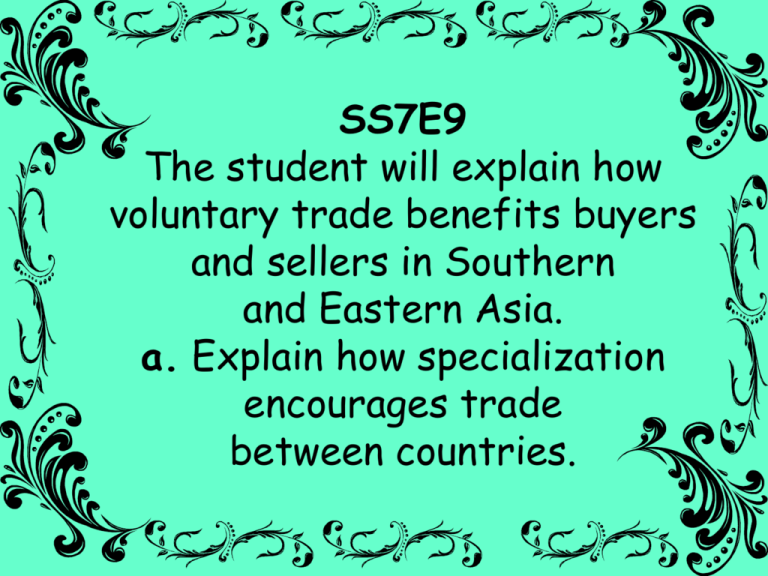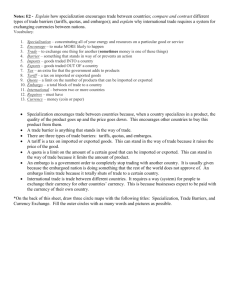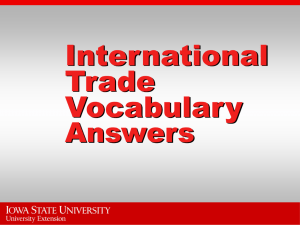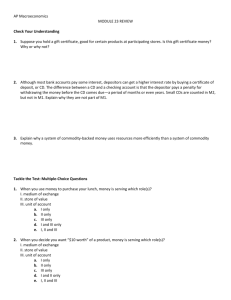SS7E9 The student will explain how voluntary trade benefits buyers
advertisement

SS7E9 The student will explain how voluntary trade benefits buyers and sellers in Southern and Eastern Asia. a. Explain how specialization encourages trade between countries. 1 Not every country can produce all the goods and services it needs. Because of this, countries specialize in producing those goods and services they can provide best and most efficiently. They look for others who may need these goods and services so they can sell their products. The money earned by such sales then allows the purchase of goods and service that the first country is unable to produce. Japan specializes in “Hello Kitty" products, among many others. 2 In international trade, no country can be completely self-sufficient. That means that no country can produce all the goods and services it needs. Specialization creates a way to build a profitable economy and to earn money to buy the items that cannot be made locally. Above are images of a pearl farm, an industry in which the countries of Vietnam and Japan specialize. 3 The countries in Southern and Eastern Asia are very different in terms of how their economies are organized. India has a lot of farm land, but the population is so large it is often difficult to grow enough food for everyone. Above: Images from a goat farm in India. 4 India has a booming industrial and technological economy. This specialization makes it possible for an economy as enormous as that of India to focus on those businesses that are most profitable. 5 The country of China has also focuses on those businesses that the Chinese have found to be the most profitable. Some areas of the country are almost all agricultural. Others areas have large cities and modern industries. 6 Japan is a country with very few natural resources, so specialized industries have been developed to earn money needed to buy food and raw materials from other countries. 7 North Korea has had many problems in their attempts to improve harvests on their farms. As a result, the North Korean government has had to turn to industries that use the country’s natural resources like iron and coal in order to keep the 63349866 economy going. Specialization allows countries like North Korea to produce what they produce best and generate income to buy what they still need. 8 SS7E9 The student will explain how voluntary trade benefits buyers and sellers in Southern and Eastern Asia. b. Compare and contrast different types of trade barriers such tariffs, quotas and embargoes. 9 Trade barriers are anything that slows down or prevents one country from exchanging goods with one another. Some trade barriers are put in place to protect local industries from lower priced goods made in other countries. 10 Other times trade barriers are created due to political problems between countries. Trade is stopped until the political issues are settled. The countries in Southern and Eastern Asia, as in most parts of the world, have experienced trade barriers at one time or another. 11 A tariff is a tax placed on goods when they are brought into, or imported, from one country to another country. The purpose of a tariff is usually to make the imported item more expensive than a similar item made locally. This sort of tariff is called a protective tariff because it protects local manufactures from competition coming from cheaper goods made in other countries. 12 A quota is a different way of limiting the amount of foreign goods that can come into the country. A quota sets a specific amount or number of a particular product that can be imported or acquired in a given period of time. 13 A third type of trade barrier is called an embargo. An embargo is when one country announces that it will no longer trade with another country in order to isolate the country and cause problems with that country’s economy. 14 Embargos usually com about when two countries are having political disputes. Embargos often cause problems for all countries involved. 15 SS7E9 The student will explain how voluntary trade benefits buyers and sellers in Southern and Eastern Asia. c. Explain why international trade requires a system for exchanging currencies between nations. 16 Most of the countries in Southern and Eastern Asia have their own type of currency, or money. In order for them to pay for goods as they trade with each other, they have to establish a system for changing one type of currency to another. This system is known as an exchange rate. 17 Countries also have to be able to exchange their currencies with those used by other countries around the world. The currency of the U.S. is based on the dollar. Much of the currency in Western Europe is called the Euro. In Southern and Eastern Asia, there are many types of currency. In order for them to trade with each other, they have to be able to figure out what goods cost in each currency. Images of Indonesian (left) and (right) Indian currency. 18 Country Currency Equivalent in U.S. Dollars United States dollar $ $1.00 India rupee 41.5 per dollar China yuan 7.16 per dollar Japan yen 117 per dollar North Korea won 140 per dollar Vietnam dong 16, 000 per dollar 19









